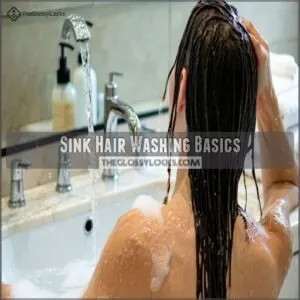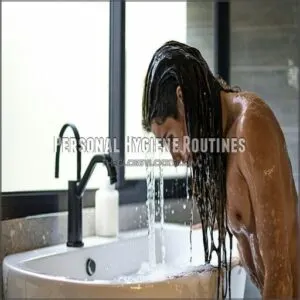This site is supported by our readers. We may earn a commission, at no cost to you, if you purchase through links.
 To wash your hair in the sink, start by gathering your supplies—shampoo, conditioner, and a towel.
To wash your hair in the sink, start by gathering your supplies—shampoo, conditioner, and a towel.
Lay the towel around your neck to catch drips (trust me, your shirt will thank you later). Position yourself comfortably with your head tilted back, and use a cup to wet your hair thoroughly.
Apply shampoo and massage your scalp with your fingertips—not your nails, unless you’re going for that "just scratched by a cat" look.
Rinse completely, add conditioner if needed, then rinse again. Pat your hair dry instead of rubbing it, which might help you achieve a better look and feel, and those sink-washing skills might just save you when your shower decides to take an unexpected vacation.
Table Of Contents
Key Takeaways
- Prep your space by rolling up your sleeves, draping a towel over your shoulders, and ensuring the sink area is ready to avoid a mess.
- Use lukewarm water, apply a small amount of shampoo to your roots, and massage with your fingertips for a thorough clean.
- Rinse thoroughly, ensuring no shampoo residue is left, and use a removable faucet or a cup to wet and rinse your hair effectively.
- Avoid neck strain by leaning at a comfortable angle or using support like a folded towel under your elbows.
Sink Hair Washing Basics
You’ll never master the art of sink hair washing until you’ve flooded your bathroom at least once, trust me, we’ve all been there.
Whether you’re running late or just can’t be bothered with a full shower, mastering the sink wash will save your greasy hair (and social life) in a pinch.
Time Constraints and Convenience
Time crunch? Sink hair washing is your new BFF.
When you’re running late for work or just too lazy for a full shower, this quick hair wash technique saves precious minutes.
You’ll appreciate the sink washing benefits on those mornings when dry shampoo won’t cut it.
Perfect for unexpected social calls or daily washers, this timesaving hair care approach keeps you looking fresh without the full shower commitment, providing a great solution for a quick hair wash.
Practical Clothing Choices
Fashion disaster alert! When washing your hair in the sink, sleeve length is super important—roll ’em up or rock a tank top to avoid the dreaded wet-arm syndrome.
Drape a towel around your shoulders for epic water protection (your favorite shirt will thank you).
Bathrobes are sink-washing superheroes, while quick-dry clothing materials make the whole experience way less messy.
Trust me, proper towel placement is a game-changer!
High-Quality Shampoo Selection
Shampoo selection makes or breaks your sink washing experience.
Choose products with quality ingredients suited to your hair type—whether it’s oily, dry, or normal.
Your scalp health depends on the right pH balance and sulfate content.
Many drugstore options pack the same punch as salon brands, just check those labels.
When washing hair in the sink, a little quality shampoo goes a long way.
To find the best option, consider using quality shampoo products.
Washing Hair in Sink
You’ll be amazed how a good sink wash can save your greasy hair (and social life) when you’re running late or just too lazy for a full shower.
A quick sink wash is your greasy hair’s superhero, saving both your look and your day in record time.
Whether you’re dodging unexpected guests or maintaining daily hair cleanliness without the time commitment, this old-school technique is your new best friend for those "my hair looks like I deep-fried it" emergencies, and it’s especially useful for dealing with greasy hair.
Historical and Cultural Perspectives
Tradition reveals fascinating stories about sink hair washing across generations.
Before modern bathrooms, families used kitchen sinks or galvanized tubs for bathing, with parents often going last after the kids.
In some cultures, Cultural Buckets provided fresh water for each family member.
Limited Facilities meant creative hygiene solutions, like washing children in sinks.
These Past Bathing practices have evolved, but they’ve shaped our modern hair washing traditions and cultural approaches to cleanliness.
Personal Hygiene Routines
Everyone’s daily hygiene routines differ like night and day.
Some folks shower daily while others prefer every other day.
When you’re in a rush, sink hair washing becomes your best friend! It fits perfectly between your handwashing habits and oral hygiene routine.
Just make sure to adjust your hair washing methods based on your skin care needs and lifestyle. Trust me, it’s a game-changer for busy mornings, and finding the right balance is a lifestyle necessity.
Medical Conditions and Physical Limitations
While everyone’s morning routine is different, some physical challenges can make sink washing tricky.
If you’re dealing with neck injuries or mobility challenges, leaning over can actually be dangerous – it might pinch nerves or even damage arteries.
- Try adaptive techniques like shampoo funnels or inflatable basins if you’re wheelchair-bound
- Ask for caregiver assistance rather than risking injury
- Consider dry shampoo options when limited movement makes traditional washing impossible
Preparing for Sink Washing
You’ll save yourself from a soaking disaster if you take just a minute to prep your sink washing station with rolled-up sleeves and a towel draped around your shoulders.
Getting everything ready beforehand means you can focus on washing your hair instead of playing that fun game called "why is my entire bathroom suddenly underwater?
Rolling Up Sleeves and Wearing Towels
Before you even turn on the tap, let’s get you prepped right! First, roll those sleeves way up—or better yet, rock a tank top to avoid the dreaded wet-sleeve syndrome.
Consider using protective arm coverings to keep your sleeves dry.
Drape a towel around your shoulders like a cape (superhero of sink washing, that’s you!).
This simple towel placement prevents water damage to your clothes while you tackle that hair washing mission.
Removable Faucets and Wetting Hair
A removable, pull-out faucet is your best friend in the context of sink hair washing.
You’ll get way better hair coverage than with fixed faucets, making the whole process less of a headache.
Position yourself comfortably and test the water temperature before diving in.
Many people struggle with wetting the back of their head, so angle the spray strategically or use a cup for those hard-to-reach spots, and this will make the process easier with a removable, pull-out faucet, providing better hair coverage.
Thorough Lathering and Rinsing Techniques
You’ll master the sink-washing game with proper lathering and rinsing techniques.
Apply shampoo to your roots only and let those suds work their magic as they run down during rinsing. After dunking your head, massage that shampoo in like a pro.
For less mess, use a pitcher for controlled wetting and rinsing. Those with curly hair may benefit from co-washing techniques to retain moisture.
Save water by turning off the tap while lathering—your water bill will thank you!
Effective Sink Washing Techniques
Four key techniques will transform your sink hair washing game.
Start with lukewarm water temperature—too hot strips natural oils, too cold won’t remove grime effectively.
Regarding shampoo application, less is more!
Squeeze a quarter-sized amount onto your palm and work into a lather before applying to your hair.
Focus on your scalp massage technique—use fingertips (not nails!) to work in circular motions, especially at the crown where oil builds up.
"I always spend extra time on my scalp," says my friend Lisa, "it’s like a mini spa moment!"
Rinsing thoroughly is non-negotiable with sink washing methods—missed shampoo causes irritation and dullness.
Get every last bubble out!
For effective hair washing techniques in the sink, tilt your head at different angles to guarantee complete coverage during both washing and rinsing.
Maintaining Hair Health
You’ll still need to keep your locks healthy even when you’re doing the sink-washing thing, and trust me, your hair will thank you for it.
From follicle-friendly shampoos to quick dry sprays that don’t make you look like you stuck your finger in an electrical socket, these simple hacks will keep your mane looking fabulous without the full shower commitment, using simple hacks.
Dry Shampoo Sprays and Rinse-Free Sponges
Between sink washes, you’ve got awesome options to keep your hair fresh.
Dry shampoo sprays work magic on greasy roots—just spritz, wait 30 seconds, and brush through.
For totally hands-free cleaning, rinse-free sponges like Scrubzz contain gentle cleansers that whisk away oil without water.
Both options are super cost-effective compared to daily shampooing and can extend your style’s life when you’re too busy (or lazy) for the sink routine.
Follicle-Cleaning Shampoos and Regular Haircuts
Your scalp deserves some serious TLC when you wash hair in the sink. Regular follicle-cleaning shampoos and haircuts are game-changers for maintaining healthy locks.
Ketoconazole fights fungus and can be found in some shampoos.
- Your scalp literally does a happy dance when you use products with tea tree oil
- Nothing feels more invigorating than that post-haircut lightness during a sink wash
- Barber visits every 6-8 weeks keep split ends from crashing your hair party
- Those shampoo ingredients you can’t pronounce? They’re your hair’s best friends
Simple Cuts and Styles for Easy Maintenance
Beyond keeping your hair clean, choosing the right cut makes sink washing a breeze!
| Style Type | Benefits for Sink Washing |
|---|---|
| Pixie Cut | Dries in minutes, minimal product needed |
| Bob Length | Easy to wet fully, quick styling |
| Layered Cuts | Requires less water, dries faster |
| Undercut | Less hair to wash, modern look |
| Textured Crop | Natural air-dry finish, no fuss |
Simple haircuts mean less time hunched over the sink — your back will thank you, as it results in a modern look and allows for quick styling!
Frequently Asked Questions (FAQs)
Is it okay to wash your hair in the sink?
Yes, it’s absolutely okay to wash your hair in the sink.
Nearly 40% of people do it occasionally, it’s a practical solution when you’re short on time or can’t take a full shower.
How to wash yourself at the sink?
You’ll need a washcloth, soap, and towel. Wet the cloth, apply soap, and wipe your face, underarms, and body. Rinse the cloth between areas and pat dry when finished.
Is sink water ok for hair?
Sink water is generally fine for your hair, but it depends on your local water quality.
You’ll want to check for hard water, which can leave residue and make your hair feel dry.
Will sink washing damage my hair?
Just as gentle raindrops nourish plants, sink washing won’t damage your hair.
You’ll be fine if you use good products, rinse thoroughly, and don’t make it too hot.
It’s actually quite practical!
How often can I wash hair in sink?
You can wash your hair in the sink daily if needed, but don’t overdo it.
Stick to every other day or so to keep your scalp happy and avoid turning it into a cleaning obsession!
Is sink washing suitable for all hair types?
Think of your hair like a garden—it needs care specific to its type.
Sink washing works for most hair, but thick curls or long locks might need extra effort.
Play around and see what works best!
Can I condition hair in the sink?
Just grab a small dollop of conditioner, work it through your hair like you’re spreading butter on toast.
It’s quick, easy, and your hair will feel soft and fabulous, and rinse thoroughly.
How to avoid neck strain while sink washing?
Prop up your head with a folded towel on the counter or use a cushion under your elbows for support.
Also, lean at an angle that’s comfy—nobody needs a sink-induced chiropractor visit!
Conclusion
Who needs a shower when the sink can be your secret weapon?
Mastering how to wash your hair in the sink isn’t just a survival skill—it’s a game-changer for busy mornings, broken showers, or those lazy “I’m not dealing with the whole bathroom” moments.
With a little prep, some pro-level lathering, and rinse techniques that’d make shampoo commercials jealous, you’re all set.
So grab that towel, save your shirt, and own the sink-washing life like a boss.












